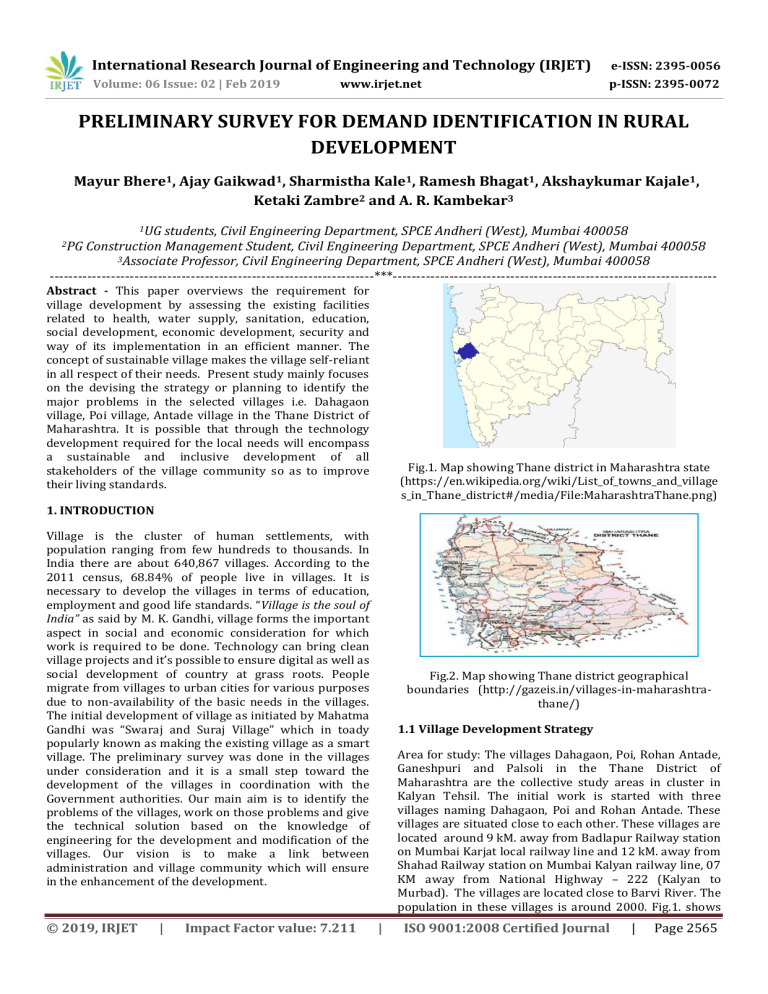IRJET-Preliminary Survey for Demand Identification in Rural Development
advertisement

International Research Journal of Engineering and Technology (IRJET) e-ISSN: 2395-0056 Volume: 06 Issue: 02 | Feb 2019 p-ISSN: 2395-0072 www.irjet.net PRELIMINARY SURVEY FOR DEMAND IDENTIFICATION IN RURAL DEVELOPMENT Mayur Bhere1, Ajay Gaikwad1, Sharmistha Kale1, Ramesh Bhagat1, Akshaykumar Kajale1, Ketaki Zambre2 and A. R. Kambekar3 1UG students, Civil Engineering Department, SPCE Andheri (West), Mumbai 400058 Construction Management Student, Civil Engineering Department, SPCE Andheri (West), Mumbai 400058 3Associate Professor, Civil Engineering Department, SPCE Andheri (West), Mumbai 400058 ---------------------------------------------------------------------***--------------------------------------------------------------------2PG Abstract - This paper overviews the requirement for village development by assessing the existing facilities related to health, water supply, sanitation, education, social development, economic development, security and way of its implementation in an efficient manner. The concept of sustainable village makes the village self-reliant in all respect of their needs. Present study mainly focuses on the devising the strategy or planning to identify the major problems in the selected villages i.e. Dahagaon village, Poi village, Antade village in the Thane District of Maharashtra. It is possible that through the technology development required for the local needs will encompass a sustainable and inclusive development of all stakeholders of the village community so as to improve their living standards. Fig.1. Map showing Thane district in Maharashtra state (https://en.wikipedia.org/wiki/List_of_towns_and_village s_in_Thane_district#/media/File:MaharashtraThane.png) 1. INTRODUCTION Village is the cluster of human settlements, with population ranging from few hundreds to thousands. In India there are about 640,867 villages. According to the 2011 census, 68.84% of people live in villages. It is necessary to develop the villages in terms of education, employment and good life standards. “Village is the soul of India” as said by M. K. Gandhi, village forms the important aspect in social and economic consideration for which work is required to be done. Technology can bring clean village projects and it’s possible to ensure digital as well as social development of country at grass roots. People migrate from villages to urban cities for various purposes due to non-availability of the basic needs in the villages. The initial development of village as initiated by Mahatma Gandhi was “Swaraj and Suraj Village” which in toady popularly known as making the existing village as a smart village. The preliminary survey was done in the villages under consideration and it is a small step toward the development of the villages in coordination with the Government authorities. Our main aim is to identify the problems of the villages, work on those problems and give the technical solution based on the knowledge of engineering for the development and modification of the villages. Our vision is to make a link between administration and village community which will ensure in the enhancement of the development. © 2019, IRJET | Impact Factor value: 7.211 Fig.2. Map showing Thane district geographical boundaries (http://gazeis.in/villages-in-maharashtrathane/) 1.1 Village Development Strategy Area for study: The villages Dahagaon, Poi, Rohan Antade, Ganeshpuri and Palsoli in the Thane District of Maharashtra are the collective study areas in cluster in Kalyan Tehsil. The initial work is started with three villages naming Dahagaon, Poi and Rohan Antade. These villages are situated close to each other. These villages are located around 9 kM. away from Badlapur Railway station on Mumbai Karjat local railway line and 12 kM. away from Shahad Railway station on Mumbai Kalyan railway line, 07 KM away from National Highway – 222 (Kalyan to Murbad). The villages are located close to Barvi River. The population in these villages is around 2000. Fig.1. shows | ISO 9001:2008 Certified Journal | Page 2565 International Research Journal of Engineering and Technology (IRJET) e-ISSN: 2395-0056 Volume: 06 Issue: 02 | Feb 2019 p-ISSN: 2395-0072 www.irjet.net the map showing Thane district in Maharashtra state and Fig.2. shows the geographical boundaries of the Thane district. a) These villages are provided with tap water but there is absence of water treatment facility for drinking water security. b) Focus on proper sewerage system c) Training to skill development of labours d) Required irrigation system e) Need for the Bio-gas plant f) Change from traditional crops to cash crops g) Use of chemical fertilizers, insecticide and weedicides and education on it h) Awareness about immunization. 1.2 Meetings with administrative Heads of the Villages in Local Gram panchayat Meeting of UG and PG students was organised with the village administrative heads and local representatives including sarpanch and the members of the Gram Panchayat. In this meeting the information is gathered including some basic information of the village, the major and minor needs of the people in the villages, local population, number of people in that village, total area under the village, facilities provided by the Gram Panchayat, and other basic information. This has resulted into a reflection of the present scenario of the villages and helped to zero down the focus areas. The percent of people responded as per issues are shown in Fig.3. 10% 10% 1.3 Household Survey 50% Random households were visited for preliminary survey among these three villages. The number of responses recorded was 102 from Dahagaon, 115 from Poi and 30 from Rohan Antade. In household survey, the basic information about a family like number of persons is in the family, their age, education, health, livelihood, agriculture related information and many other issues which are related to their day to day life like, problems faced by the villagers in their village and number of Government schemes reaching to the villages and finally prioritization these problems were collected. This information will be useful to prepare village development plan according to identified needs and requirements. The basic information is tabulated in Table 1 as given. 30% % Features % Rice 70 Lady Finger 30 Agriculture 60 Job/Service 40 Irrigated Land 20 Non Irrigated 80 Drainage Facilities Irrigation Transport Fig. 3 Response received 1.5 Planning for future The major problem identified in the three villages was the untreated water provided to the people for drinking purpose. This water is directly lifted from the Barvi river nearby of Dahagaon village. This river is Perennial River and flows throughout the year, but there is no treatment plant for purifying the water and maintaining the quality of water. Thus it becomes necessary that the provision shall be made for water treatment plant. With respect to the survey following aspects were noted and focus will be given on all these aspects. These includes; Environmental and Hydraulic aspect Table 1. Basic information collected from villages Features Treated Water Land Treated Water 10 Untreated Water 90 1. Location of treatment plant Good Transport 60 Poor Transport 40 2. Checking the quality of water 3. Estimate the total purified water requirement 1. 4 Problem Identification 4. Coagulation and flocculation are the first steps in water treatment. Based on the House hold survey and village level survey the following scenarios were identified as priority issue faced by the villagers and as per their demands: © 2019, IRJET | Impact Factor value: 7.211 5. Sedimentation followed by filtration, chlorination and ion exchange method. | ISO 9001:2008 Certified Journal | Page 2566 International Research Journal of Engineering and Technology (IRJET) e-ISSN: 2395-0056 Volume: 06 Issue: 02 | Feb 2019 p-ISSN: 2395-0072 www.irjet.net The construction aspect includes; 1. Intake structure and pumping station. 2. Sedimentation tank. 3. Sand filter bed. 4. Disinfection unit. 5. Water tank at high altitude for storing purified water at high altitude. 6. Water supply lines. 2. Conclusions This study basically discusses the importance of preliminary survey for demand identification in rural development. The villages’ survey can be useful in demand identification based on needs of the local residents. Preliminary and reconnaissance survey are important in the scenario mapping for future developments. REFERENCES 1. G. Prasad and E. Visagie, "Impact of energy reforms on the poor in Southern Africa," 2006. 2. G. A. UN, "Transforming our world: The 2030 agenda for sustainable development," A/RES/70/1, 21 October2015. 3. D. Schnitzer, D. S. Lounsbury, J. P. Carvallo, R. Deshmukh, J. Apt, and D. M. Kammen, "Microgrids for Rural Electrification: A critical review of best practices based on seven case studies," United Nations Foundation, 2014. 4. V. G. Garcia and M. M. Bartolomé, "Rural electrification systems based on renewable energy: The social dimensions of an innovative technology," Technology in Society, vol. 32, no. 4, pp. 303-311, 2010. 5. P. Thollander and M. Ottosson, "Energy management practices in Swedish energy-intensive industries," Journal of Cleaner Production, vol. 18, no. 12, pp. 1125-1133, 2010. 6. D. F. Barnes and W. M. Floor, "Rural Energy in Developing Countries: A Challenge for Economic Development1," Annual review of energy and the environment, vol. 21, 1996. 7. R. Palma-Behnke, L. Reyes, and G. Jimenez-Estevez, "Smart grid solutions for rural areas," in Power and Energy Society General Meeting, 2012 IEEE, 2012, pp. 1-6: IEEE. [11] M. Y. Wu, M. I. Ridzuan, and S. Z. Djokic, "Smart grid functionalities for improving reliability of rural electricity networks," 2016. © 2019, IRJET | Impact Factor value: 7.211 | ISO 9001:2008 Certified Journal | Page 2567







